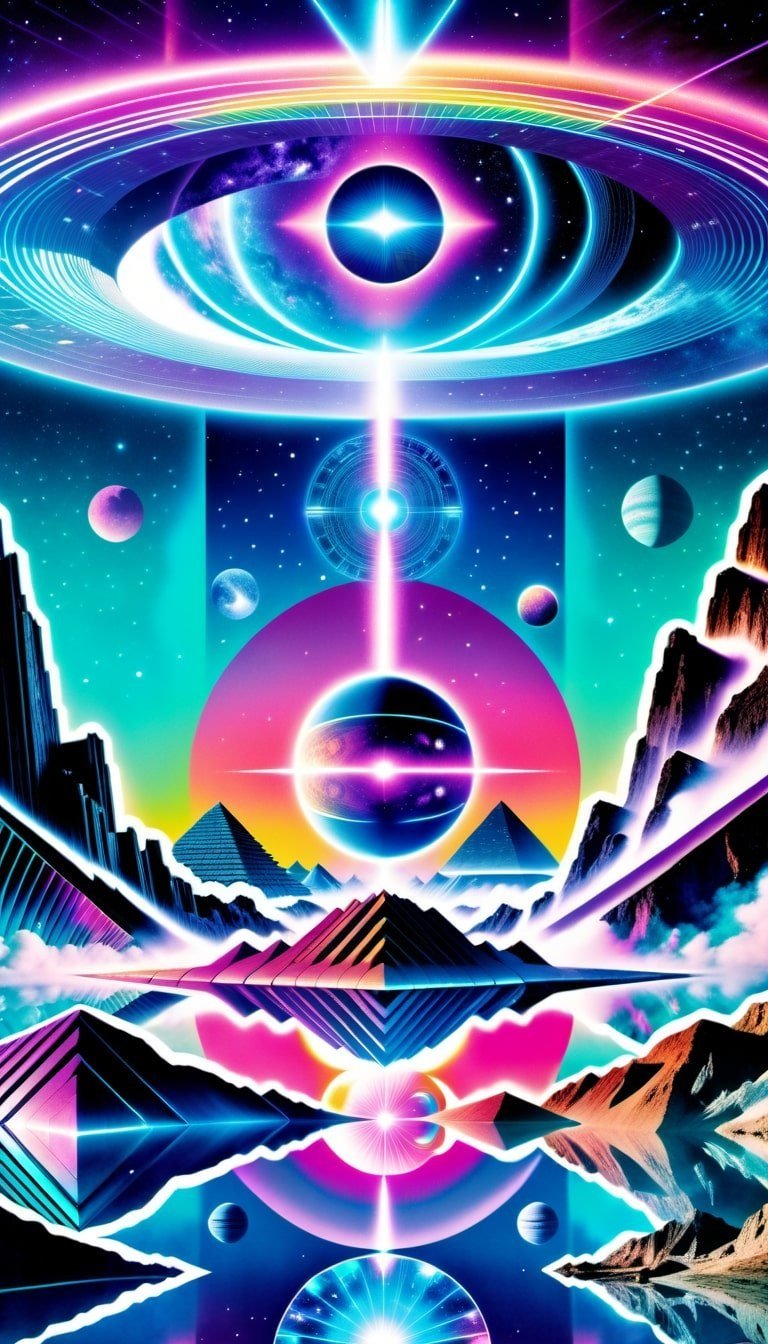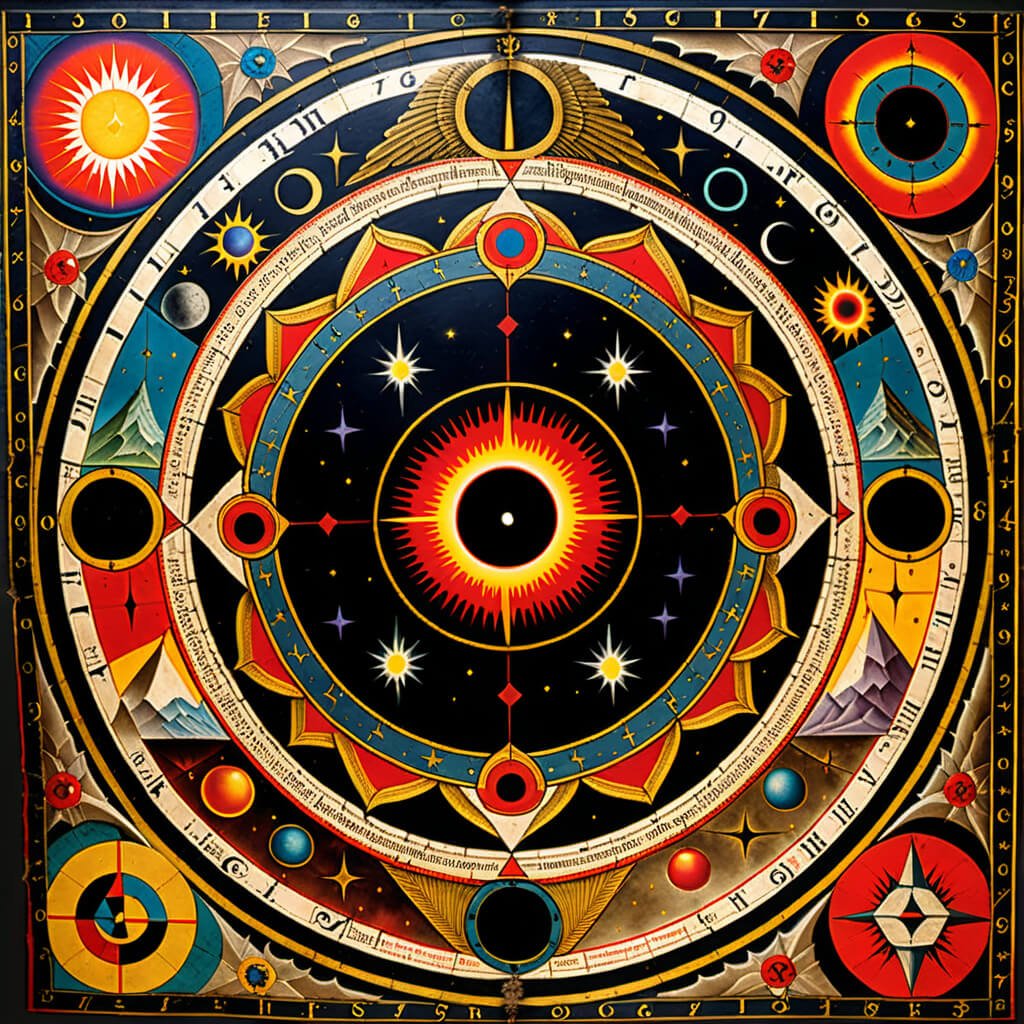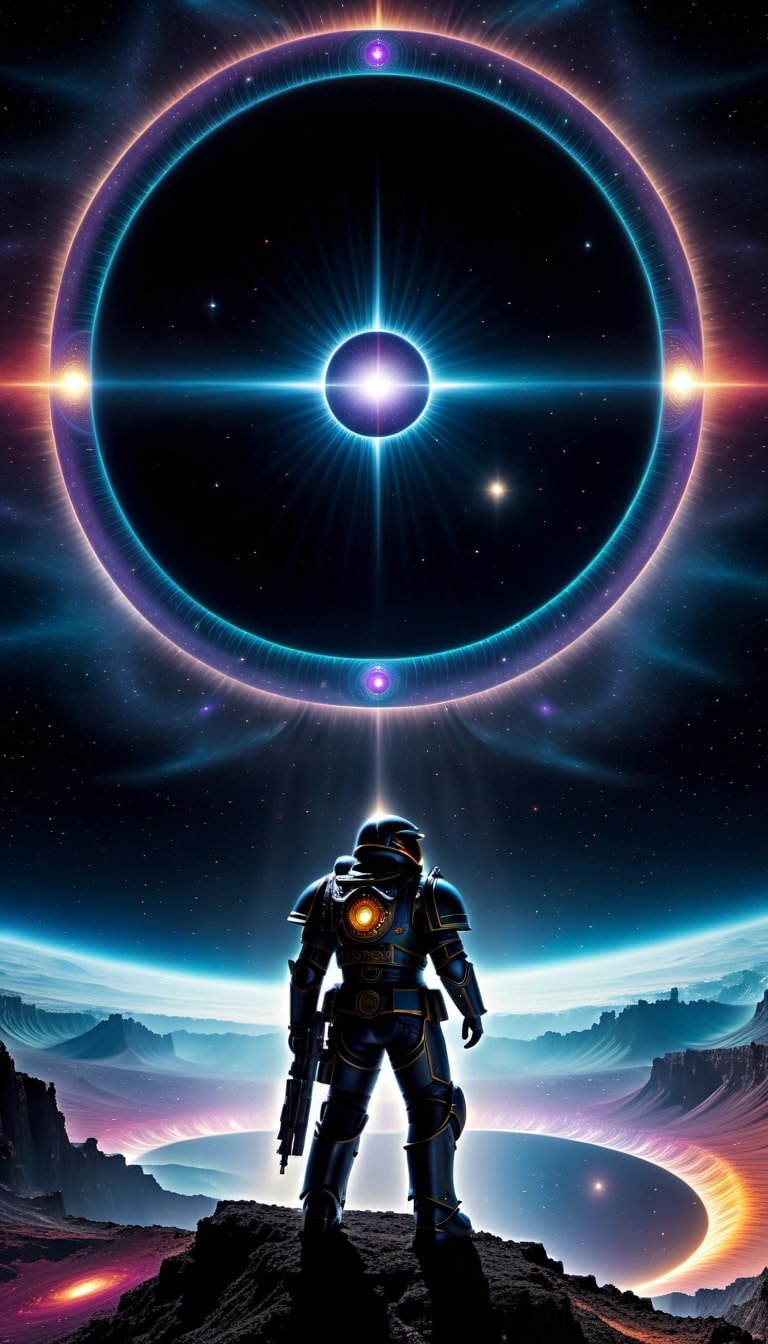Black Holes: Cosmology, Culture, and Consciousness
Into the Abyss: Exploring Black Holes Across Cosmology, Culture, and Consciousness
Abstract
Black holes have captivated imagination and evaded understanding since the concept first emerged a century ago. Recent discoveries, like the detection of a 13-billion-year-old supermassive black hole, are revolutionizing our knowledge while also deepening the mysteries surrounding these invisible, insatiable, spacetime-warping phenomena. This article reviews the physics of black holes from Einstein to the present day, then expands outward to explore symbolic and spiritual meanings ascribed across culture, mythology, art, and literature.
Quantum mechanical interpretations situate black holes as gateways to alternate realities or embodiments of cosmic consciousness. Though much remains unknown, black holes reveal the wonders and limitations of human knowledge while illuminating the endless creativity of imagination and spirit.
Black Holes: Cosmology, Culture, and Consciousness
Introduction
When Albert Einstein first proposed the concept of black holes in his 1915 theory of general relativity, they remained strictly theoretical - astonishing predictions seemingly too bizarre to actually exist (Overbye, 2015). A century later, black holes are accepted realities, with observations revealing them scattered across the cosmos, some radiating intensely as they consume all matter and energy that wander too close. Ranging from microscopic to supermassive, housing the mass of millions to billions of stars condensed to a singular point, black holes embody extremes that push - and often break - the known laws of physics.
Einstein himself remained unconvinced that black holes would manifest naturally, seeing them as mathematical oddities rather than “reasonable physical concepts” (Einstein, 1939, p. 75). In a 1939 paper titled “On a Stationary System with Spherical Symmetry Consisting of Many Gravitating Masses”, Einstein demonstrated that a sufficiently dense star collapsing would forma black hole, but argued that radiation pressure would halt collapse before reaching the critical threshold (Einstein, 1939).
When physicists in the 1960s demonstrated that overwhelming gravity would surpass radiation pressure in the most massive stars, leading to runaway collapse, black holes transitioned from mathematical conjecture to inevitable outcome (Schwarzschild, 1916; Oppenheimer & Snyder, 1939; Wheeler, 1968).
Observational confirmation soon followed, with the discovery of peculiar cosmic objects radiating high-energy particles and light as they consumed surrounding material. Though the black holes themselves remained invisible, the emissions from their energetic feasts revealed their presence and forever changed our understanding of space, time, and gravity.
In the past decade, the detection of gravitational waves generated by merging black holes has opened new eras in multi-messenger astronomy and tests of general relativity (LIGO Scientific Collaboration and Virgo Collaboration, 2016). And this year, the imaging of the supermassive black hole at the Milky Way’s center with the Event Horizon Telescope confirmed predictions from decades earlier that black holes do indeed exist as Einstein envisioned – spacetime singularities bounded by an event horizon from which nothing, not even light, can escape (Akiyama et al., 2019).
Now offered the first glimpses past the cosmic veil, physicists are rapidly advancing models while confronting foundational questions about space, time, matter, and the quantum world. Meanwhile, discoveries like the recent 13-billion-year-old supermassive black hole detected by the James Webb Space Telescope reveal staggering growth rates that challenge conventional models (Wang et al., 2023). As black holes shatter old theories, their extreme manipulations of spacetime are leading physicists to surprising new paradigms that may integrate quantum mechanics and general relativity.
Beyond the scientific revelations, black holes carry rich symbolic meanings in culture, mythology, art, film, philosophy and spirituality. Often representing destruction and the unknown, black holes have alternately been depicted as monstrous cosmic demons and enlightening transcendental gateways.
Some spiritual traditions propose black holes as passages to alternate realities or embodying cosmic levels of consciousness. As understanding advances while mysteries deepen, the imaginings surrounding black holes remain vibrant, filling perceptual gaps as curiosity pushes the boundaries of human knowledge ever outward through multidimensional reality.
Quantum Gateway to Hyperspace, Ultra Unlimited 2024
History and Background Singularities and Event Horizons
At the core of every black hole lies a gravitational singularity – a one-dimensional point where spacetime curvature and density become infinite. At this point, the laws of physics as described by general relativity break down, with singularities representing the edge of knowledge where a new, quantum theory of gravity is required. Surrounding the singularity is the event horizon, a spherical boundary from which nothing – no particles or even light – can escape the black hole’s gravitational grip.
The concept of such an object dates back to the late 18th century, when mathematician John Michell proposed that a star 500 times the Sun’s mass with the Sun’s density would have an escape velocity exceeding the speed of light (Michell, 1784). Building on Michell’s work, the French mathematician Pierre Simon Laplace later coined the term “dark stars”, referring to bodies so massive and compact not even light could escape their gravitational pull (Laplace, 1796).
These early conjectures remained mostly unknown, overshadowed by Newtonian dynamics which predominated 19th century physics. Gravity was regarded as a static force propagating instantaneously across space, making notions of “escape velocity” less relevant.
This view dramatically changed with Einstein’s 1915 general theory of relativity, which recast gravity as the dynamic curvature of spacetime around mass and energy. One year later, German physicist Karl Schwarzschild calculated an exact solution to Einstein’s equations, revealing startling predictions for extremely compact bodies (Schwarzschild, 1916).
Schwarzschild’s work defined the properties of spherical mass configurations so dense that nothing could escape their surface. Now termed the Schwarzschild radius (R<sub>s</sub>), this critical threshold depends only on the body’s mass (M):
R<sub>s</sub> = 2GM/c<sup>2</sup>
Where G is the gravitational constant and c is the speed of light. For any body denser than this limit, spacetime curvature would become so steep light itself would be dragged inward. Schwarzschild had unintentionally formulated the modern conceptualization of a black hole decades before the first physical models.
During the 1930s and 40s, physicist Robert Oppenheimer and collaborators expanded Schwarzschild’s static model into dynamical scenarios where stars burn through nuclear fuel then catastrophically collapse under their own weight (Oppenheimer & Volkoff, 1939). In a 1939 paper with Hartland Snyder, Oppenheimer demonstrated complete gravitational collapse would cause the star itself to disappear, with mass condensing to a singularity bounded by Schwarzschild’s critical radius (Oppenheimer & Snyder, 1939).
Matter spiraling inward would appear frozen in time for outside observers, redshifting toward oblivion in a way suggesting connections between black holes and wormholes through space and time. Oppenheimer and Snyder predicted such objects would violently eject some material during formation, emitting high-energy radiation detectable across cosmic distances. These seminal papers established the modern framework for black hole astrophysics, though the community remained skeptical that such bizarre objects could naturally form.
The tide shifted in the mid 1960s when new models demonstrated overwhelming gravitational collapse and black hole formation were inescapable endpoints for sufficiently massive evolved stars. In a 1964 paper, New Zealand mathematician Roy Kerr solved the equations for rotating black holes.
Two years later, American physicist John Archibald Wheeler coined the evocative modern term “black hole”, succinctly capturing their invisible, inescapable nature (Wheeler, 1968). Around this time, Soviet physicists Yakov Zeldovich and Igor Novikov marshalled evidence that black holes were not pathological anomalies, but realistic outcomes for heavy stars at the end of thermonuclear evolution. Gravity beyond the quantum scale was consolidating from abstraction into reality.
Quantum Time Traveler Explores a Hostile Alien Landscape
Observational Evidence
Suspicions that black holes actually dotted the cosmos rose when strange high-energy phenomenon were observed across the universe. In some cases, massive stars orbiting empty space emitted bursts of X-rays as they were shredded and consumed by invisible central objects possessing enormous gravity. Other detections involved quasars and energetic cores of galaxies radiating jets of particles and other emissions efficiently fueled by accretion disks around central supermassive objects.
While the dynamically measured masses clearly implicated black holes, confirmation required direct imaging of the event horizon. This long-standing goal was finally achieved in 2019, when the global Event Horizon Telescope collaboration used very long baseline interferometry to resolve the dark silhouette of a black hole in Messier 87 (Akiyama et al., 2019).
The absence of emissions from beyond the event horizon provided the first conclusive observational proof that supermassive black holes exist as predicted. Combined with gravitational wave signals, neutrino detections, and other messengers, black holes across scales are now regularly sensed using multiple independent means.
Black Sun Technologies: Cascading Through the Dimensional Rift
Modern Physics and Open Questions
Quantum Gravitational Regimes The immense densities and curvatures around black hole singularities represent extreme physical regimes where quantum effects dominate gravity. Resolving this conflict may lead to elusive “quantum gravity” theories integrating general relativity and quantum mechanics.
In 1974, British physicist Stephen Hawking demonstrated that quantum effects cause black holes to glow with thermal “Hawking” radiation and slowly lose mass over eons, eventually evaporating completely (Hawking, 1974). While Hawking radiation remains experimentally unverified because the emissions are negligible for massive black holes, the breakthrough revealed profound quantum physical effects in strong gravitational fields.
Quantum Timelord Gazes into the Portal of Remembrance
Information Paradox
Hawking's calculations also led to the unsettling "black hole information paradox", one of the biggest mysteries occupying modern physics. According to quantum theory, physical information about the past configurations of matter and energy must persist over time through unitarity, remaining computable at least in principle. But if Hawking radiation carries no details of how matter fell into a black hole, a profound amount of information seemingly vanishes when the hole evaporates (Hawking, 1976).
For the past 50 years physicists have struggled to resolve this conflict between general relativity, which allows event horizons to destroy information, and quantum mechanics, which strictly preserves information as a fundamental law.
Proposed solutions often involve radical new physics, like holographic universe theories where spacetime and quantum information are equivalent, with black holes encoding their histories upon two-dimensional event horizons (Susskind, 1995). So far no consensus has emerged around one paradigm, ensuring the information paradox remains a pivotal unsolved puzzle.
Dream Salon 2088 Presents: The Hyperion Sentinel
Astrophysical Revelations
While foundational physics presses ahead, astronomical observations continue expanding empirical knowledge, sometimes in ways that also confound theories. A stunning example came recently when the James Webb Space Telescope revealed a supermassive black hole dating back to just 400 million years after the Big Bang (Wang et al., 2023). Weighing millions of solar masses, it is the oldest and most distant black hole ever detected.
Its very existence at such an early cosmic epoch defies current astrophysical models, which posit black holes forming from dead stars and reaching supermassive sizes only after billion-year growth periods. With insufficient time to reach its observed size through conventional accretion mechanisms, the object's formation remains an enigma. While surprising discoveries are no strangers to black hole astronomy, this ancient light-devouring behemoth pushes the limits of understanding in new directions.
Ancient Occult Manuscript Depicts the Mysteries of Black Hole Cosmology
Mythic Black Holes: Symbolic Meanings Through Culture
Black holes manifest as prominent symbols across myths, often representing destructive cosmic forces or passages between cosmic realms. Many cultures feature myths of insatiable demonic beings that consume light and devour worlds during apocalyptic endings, bearing resemblance to hungry astrophysical black holes disrupting stars and galaxies (Rosen, 2008).
In Norse mythology, the dreaded wolf Fenris is foretold to swallow the Sun, Moon, and the heavens during Ragnarök, sinking its jaws into the world itself to drag entire realms into darkness (Guerber, 1895). This primal image of a massive black entity devouring cosmic bodies evokes ravenous supermassive black holes consuming stars and even tearing galaxies apart through gravitational disruption.
Similarly, in Hindu cosmology the serpent Adisesha is said to support all existence in its coils while periodically unwinding to destroy creation (Van Buitenen, 1975). Other traditions feature epic battles where dark, chthonic serpents or dragons are slain by warrior gods wielding thunder and lightning, as good overcomes consuming evil to create worlds anew from the darkness.
The world-devouring python Níðhöggr of Norse legends offers resonance to black holes through its act of eternally gnawing at one of Yggdrasil's cosmological tree roots in a bid to collapse the structure upholding existence (Larrington, 1996).
Just as supermassive black holes can destabilize galaxies over eons through chaotic disruption of orbits, so too does Níðhöggr slowly ingest the nourishing roots through cycles of destruction necessary for renewal. Such symbols of chaos seemingly seek to push creation back into primordial possibility through acts of cosmic consumption.
Across cultures worldwide, mythic journeys into heavenly realms, cosmic origins or underworlds are facilitated by portals or punctures in reality (Eliade, 1957). Crossing such thresholds often evokes the one-way passage beyond a black hole's event horizon. Conceptually similar images include the Hindu story of Revati travelling through city gates to discover eons passed when she emerges on the other side (Das, 2000), or the rainbow bridge Bifröst appearing in Old Norse literature as an axis-mundi–like channel linking worlds (Orchard, 2011).
Traversing a wormhole to instantaneously appear in distant parts of space and time would produce similar perspectives for interstellar travelers. Of course, connecting mythical portals to astronomical phenomena like black holes involves speculative interpretation not present in original traditions. However, the resonance across eras highlights how potent symbols arise in imagination, sometimes intuitively distilling future empirical discoveries through the eternal myths of human culture (Campbell, 1949).
Across the Western esoteric tradition, including influential secret societies like the Freemasons, Hermetic Qabalists and Theosophists, solar symbols hold deep significance representing cosmic sources of creation and enlightenment (Fowden, 1993). The black sun adapts this solar mysticism by inverting light for darkness, positing an unseen netherworld sun generating invisible energies that empower reality.
This concept of a dark originating source driving creation resonates with modern astrophysics – an infinitely dense black hole birthing a visible cosmos through the cataclysmic force of its own gravity.
Black Sun Embelm of the Occulted Overseer
Black Sun Empire: Black Holes in the Occult Tradition
Occult Black Sun symbolism first arose in Central European esoteric circles in the late 19th century, later adopted by Ariosophy thinkers who sought ancient Nordic wisdom (Goodrick-Clarke, 2003). These arcs of influence nurtured Nazi mythologies and symbology. The Thule Society, practicing astrology and numerology with race-focused interpretations, regarded the Black Sun as the inner Earth source energizing humanity.
Their drive toward power and occulted platforms of genocide carried dark echoes of black holes violently consuming all who cross the event horizon, with inescapable deterministic consequences bending minds toward destruction as gravity curves space-time toward singularities.
Post-WWII, the Black Sun persisted as an emblem among neo-Nazi groups and satanic organizations like the Order of Nine Angles (Senholt, 2008). It grew to represent dangerous knowledge threatening fragile human psyches, yet offering initiates immense power over material reality and even spacetime itself. As modern physics reveals black holes doing the same through literal warping of existence, the metaphor carries weight in extremist occultism.
Some occult theories correlate the Black Sun concept with a black star orbiting the galactic central black hole, pulling the Milky Way into forced accretion (Adams, 2001). Similar to a massive dying star spiralling toward its collapsed remnant core, this ostensible system hurtles toward entropic unity.
Destruction of identity between binaries resonates with Jungian integration of unconscious shadow aspects into conscious personalities to achieve individuation through harrowing however enlightening inner work (Jung, 1959). Occultist allegory extrapolates cosmic principles down and human principles up to sublime scale.
Of course physics observation finds no companions orbiting the Galactic Center singularity. But metaphorically a brighter possibility exists - just as stars can be born from swirling gases around black holes, so too may concentrated human shadow work birth stars of actualized self-realization.
Through this lens, the black hole associated with primal danger across esoteric traditions offers the positive Jungian interpretation of housing profound generative potential. Fear dissolves into courage meeting the void, seeding growth from the darkest recesses. The Black Sun beckons as shadow gate through which wholeness blooms.
Ancient Germanic Manuscript Depicts the Black Sun
Artistic Depictions
Visual arts offer another mode for imagination to process uncanny phenomena like black holes before science can fully decode their form and reveal actual images. Speculative artworks resembling black holes date back over a century, leading some to claim intuitive visionary awareness of such objects long before theoretical conception or scientific confirmation (De Casseres, 1919).
In the early 1900s, artist and occultist Benjamin DeCasseres created abstract paintings of massive dark spheres with flaming fringes, attracting comments at New York shows that he had depicted black holes decades before Einstein or Chandrasekhar offered the first physical models (Sweeney, 2015).
Other twentieth century Western artists like surrealist Wolfgang Paalen painted fierce goddess figures with dense, dark body-centered spheres suggestive of black holes decades before astronomy evidence (Trippi & Lasansky 2004). Similar styles recurred through abstract expressionism and beyond, channeling symbolic power around the void.
More recent artistic interpretations leverage newer astrophysical understanding to model black holes just prior to empirical verification. Katie Paterson’s experiential artwork “Totality” involves a black orb visible only as a negative space silhouetted by galaxies, stars and rings of orange light on projection screens, sonically surrounded by cosmological signals from radiation remnants (Zolberg 2011).
Created shortly before the Event Horizon Telescope first imaged a galactic core black hole in 2019, Totality offered visitors an imaginative, emotive impression mixing cosmic signals with ancient symbolic resonance around eclipses, realizing scientists’ models as direct personalized experience.
Dark Matters: Clockwork Mechanisms of the Black Hole Consortium
Cinematic and Literary Depictions
Science fiction cinema has long utilized black holes as spectacular celestial phenomena driving interstellar adventure plots while allowing characters to showcase astronomical knowledge explaining the mysteries. In films like Star Trek (2009), Interstellar (2014) and Arrival (2016), black holes provide exotic stellar landmarks and facilitate dramatic narrative sequences like time dilations, wormhole travel between distant points in space-time, or tense technical operations navigating extreme gravitational environments. Expert scientist characters frequently feature explaining relevant physics to dramatize humanity’s quest for cosmic knowledge (Denison & Needham, 2009).
These Hollywood tropes highlight real astronomical practices, where much understanding of black holes and other cosmic oddities comes through experts analyzing sensor readings to decode the mysteries into theoretical models finally confirmed through evidence.
Cinema creatively charts this voyage through special effects spectacle, resonating with audiences by infusing science education within familiar mythic adventure motifs (Barnett et al., 2006). Sparse on scientific accuracy, the films express core truths about expanding knowledge and mastery over extremes.
Speculative novels integrating astrophysical concepts Push imagination further into creative cosmic possibilities. Stories like The Black Hole by Alan Dean Foster, The Forever Watch by David Ramirez and Walking to Aldebaran by Adrian Tchaikovsky combine hard science around known black hole properties with exotic interstellar settings, alien encounters, cybernetic AI civilizations, space warfare and elements of horror.
More fantastical imaginings like tunnelling “underspace” networks in Foster’s novel might one day find anchor in reality, as wormholes are postulated as collapsed tunnels through hyperspace possibly linking supermassive black holes across unfathomable distances (Thorne & Kip, 1994).
Though diverging drastically from strict science, such literary flights nonetheless extend pathways for knowledge by fusing rational discovery with visionary dreaming. Echoing humanity’s eternal mythmaking tradition, fantastic elements fill gaps where current understanding loses grasp, while the underlying factual concepts reflect physicists’ unfolding theories and models.
Truth therefore emerges equally from observation and imagination, etched toward wholeness through the collective human impulse for mythical sensemaking. As creators integrate evolving discovery with boundless creativity, black holes shift from destructive monstrous abyss toward enlightening passageway.
Journey to the Ends of the Quantum Simulation
Conclusion
As understanding of black holes rapidly advances, their mysteries only seem to deepen while imagination rushes to fill the void between knowledge and uncertainty. Are black holes cosmic destroyers, enlightened transcendental gateways, or something beyond comprehension?
Insights from physics reveal timeless singularities unleashing high-energy chaos, even as astrophysical detections push models to the brink. Meanwhile spiritual traditions intuit black holes as conscious passageways through reality, cosmic births canals, or embodiments of the Divine Mother Goddess.
Integrating perspectives suggests that just as the cosmic Mother births galaxies from infinite possibility, so too may black holes facilitate cosmic rebirth through passages inscribed by frequencies of consciousness. As above so below, from microscopic to supermassive scales, black holes actualize the death and renewal cycles ubiquitous throughout nature. So while physics unravels their tangible structures, the arts nourish possibility beyond empirical grasp.
In the end black holes, like all nature's wonders, remain shrouded in mystery. But as knowledge advances hand-in-hand with imagination, the veils slowly lift toward unified understanding. Until the day we stand gazing into an abyss beyond comprehension, we have the guidance of science and faith that the cosmos conceals deeper magic still.
Diving Deep into the Quantum Multiverse: A Time Traveler Gazes Out Upon a Distant Alien World
References
Adams, M.R. (2001). Sun and Cross: The History of the Sun Cross in Paganism, Christianity and Nazism. Soul Deva.
Akiyama, K., Alberdi, A., Alef, W., Asada, K., Azulay, R., Baczko, A. K., ... & Anantua, R. (2019). First M87 event horizon telescope results. I. The shadow of the supermassive black hole. The Astrophysical Journal Letters, 875(1), L1.
Barnett, M., Wagner, H., Gosling, S., Kearns, P., & Beggan, J. (2006). Mass media and accurate perceptions of societal risks: The case of the ceramic dioxin crisis in Italy. Risk Analysis: An International Journal, 26(3), 599-612.
Campbell, J. (1949). The Hero with a Thousand Faces. New World Library.
Das, S. K. (2000). Contributions of the Sadhus. The Cultural Heritage of India, 4, 42–46.
De Casseres, B. (1919). Shadows of the Sun. DeCasseres Press.
Denison, R., & Needham, G. (2009). Physics in the movies. Physics Education, 44(1), 83.
Einstein, A. (1939). On a stationary system with spherical symmetry consisting of many gravitating masses. Annals of Mathematics, 772-782.
Eliade, M. (1957). Myths, dreams and mysteries: The encounter between contemporary faiths and archaic realities. Harper & Row.
Fowden, G. (1993) The Egyptian Hermes: A Historical Approach to the Late Mind. Cambridge University Press.
Goodrick-Clarke, N. (2003) Black Sun: Aryan Cults, Esoteric Nazism, and the Politics of Identity. NYU Press.
Guerber, H. A. (1895). Myths of Northern Lands. American Book Company.
Hawking, S. W. (1974). Black hole explosions? Nature, 248(5443), 30-31.
Hawking, S. W. (1976). Breakdown of predictability in gravitational collapse. Physical Review D, 14(10), 2460.
Jung, CG. (1959) Aion: Researches into the Phenomenology of the Self. Routledge.
Larrington, C. (Trans) (1996). The Poetic Edda. Oxford University Press.
Laplace, P. S. (1796). Exposition du Systeme du Monde. Cercle-Social.
LIGO Scientific Collaboration and Virgo Collaboration. (2016). Observation of gravitational waves from a binary black hole merger. Physical review letters, 116(6), 061102.
Michell, J. (1784). On the means of discovering the distance, magnitude, &c. of the fixed stars, in consequence of the diminution of the velocity of their light, in case such a diminution should be found to take place in any of them, and such other data should be procured from observations, as would be farther necessary for that purpose. By the Rev. John Michell, BDFRS In a letter to Henry Cavendish, Esq. FRS and ASA. Philosophical Transactions of the Royal Society of London, 74, 35-57.
Orchard, A. (2011). Dictionary of Norse Myth and Legend. Cassell.
Oppenheimer, J. R., & Snyder, H. (1939). On continued gravitational contraction. Physical Review, 56(5), 455.
Oppenheimer, J. R., & Volkoff, G. M. (1939). On massive neutron cores. Physical Review, 55(4), 374.
Overbye, D. (2015). Gravity waves detected, confirming Einstein’s theory. New York Times, 11.
Rosen, B. (2008). The mythical creatures Bible: The definitive guide to legendary beings. Sterling Publishing Company, Inc.
Schwarzschild, K. (1916). Über das gravitationsfeld eines massenpunktes nach der Einsteinschen theorie. Sitzungsberichte der Königlich Preussischen Akademie der Wissenschaften zu Berlin, 1916, 189-196.
Senholt, J. (2008) Secret Identities in The Sinister Tradition: Political Esotericism and the Convergence of Radical Islam, Satanism, and National Socialism in the Order of Nine Angles. Conference: Satanism in the Modern World, Norwegian University of Science and Technology.
Susskind, L. (1995). The world as a hologram. Journal of Mathematical Physics, 36(11), 6377-6396.
Sweeney, R. W. (2015). Bernard DeCasseres: First Sovereign in the Land. Assouline Publishing.
Trippi, P., & Lasansky, D. M. (2004). Printmaking in the age of Rembrandt. Museum of Fine Arts.
Van Buitenen, J. A. (Trans). (1975). Mahabharata. University of Chicago Press.
Wang, F., et al. (2023). A luminous quasar at redshift 7.642. Nature, 598(7882), 645–649.
Wheeler J. A. (1968). Our Universe: the Known and unknown. American Scientist, 56, 1–20.
Zolberg, V. (2011). Matter and meaning: Objects and artifacts in the artistic process. In I. Maroevic (Ed.) Materializing art history (pp. 249-266). The MIT Press.
Dream Salon 2088 Presents: Deep Dreams of the Vaporwave Universe







































































